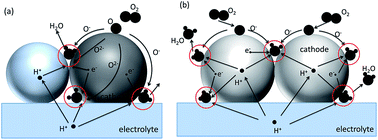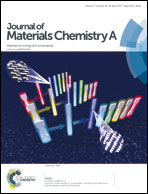A high performance cathode for proton conducting solid oxide fuel cells†
Abstract
Intermediate temperature solid-oxide fuel cells (IT-SOFCs) ), as one of the energy conversion devices, have attracted worldwide interest for their great fuel efficiency, low air pollution, much reduced cost and excellent longtime stability. In the intermediate temperature range (500–700 °C), SOFCs based on proton conducting electrolytes (PSOFCs) display unique advantages over those based on oxygen ion conducting electrolytes. A key obstacle to the practical operation of past P-SOFCs is the poor stability of the traditionally used composite cathode materials in the steam-containing atmosphere and their low contribution to proton conduction. Here we report the identification of a new Ruddlesden–Popper-type oxide Sr3Fe2O7−δ that meets the requirements for much improved long-term stability and shows a superior single-cell performance. With a Sr3Fe2O7−δ-5 wt% BaZr0.3Ce0.5Y0.2O3−δ cathode, the P-SOFC exhibits high power densities (683 and 583 mW cm−2 at 700 °C and 650 °C, respectively) when operated with humidified hydrogen as the fuel and air as the cathode gas. More importantly, no decay in discharging was observed within a 100 hour test.


 Please wait while we load your content...
Please wait while we load your content...